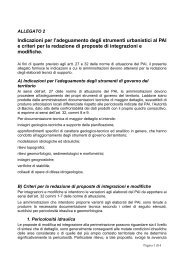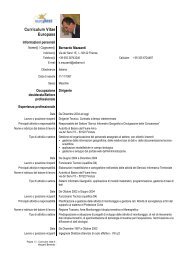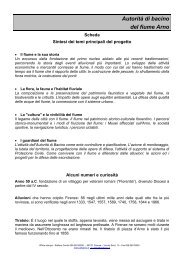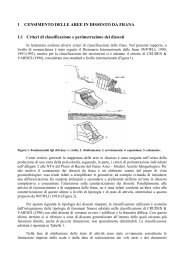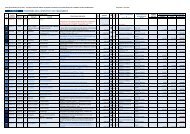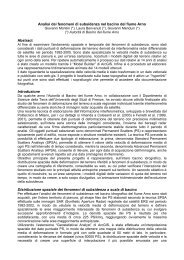11. Confidence Intervals for Flood Return Level Estimates assuming ...
11. Confidence Intervals for Flood Return Level Estimates assuming ...
11. Confidence Intervals for Flood Return Level Estimates assuming ...
You also want an ePaper? Increase the reach of your titles
YUMPU automatically turns print PDFs into web optimized ePapers that Google loves.
224 11 <strong>Flood</strong> <strong>Level</strong> <strong>Confidence</strong> <strong>Intervals</strong>with c > 1, ˆσ 2 η the Ml estimate of the variance of the driving noise η t andp + q + 1 being the number of parameters [<strong>11.</strong>5, <strong>11.</strong>6, <strong>11.</strong>25]. We choose themodel order p and q such that the Hic takes a minimum.Indirect Modelling of the Maxima Series’ ACF. Modelling the Acf of arun-off maxima series is usually hampered by the shortness of the records. Fora short time series it is often difficult to reject the hypothesis of independence,cf. Sec. <strong>11.</strong>3. To circumvent this problem, we model the daily series and assumethat the resulting process adequately represents the daily series’ Acf. It is usedto generate long records whose extracted maxima series are again modelledwith a Farima[p, d, q] process. These models are then considered as adequaterepresentatives of the empirical maxima series Acf. This indirect approach ofmodelling the maxima series’ Acf relies on the strong assumption that themodel <strong>for</strong> the daily series and also it’s extrapolation to larger time scales isadequate.Modelling a Seasonal Cycle . The seasonal cycle found in a daily riverrun-off series has a fixed periodicity of one year. It can be modelled as a deterministiccycle C(t) which is periodic with period T (1 year): C(t + T) = C(t).Combined with the stochastic model X(t) this yields the following description:Y (t) = C(t) + X(t). (<strong>11.</strong>7)In the investigated case studies C(t) is estimated by the average yearly cycleobtained by averaging the run-off Q(t) of a specific day over all M years, i.e.Ĉ(t) = 1/M ∑ jQ(t + jT), t ∈ [1, T], cf. [<strong>11.</strong>28].Including a Static Non-Linear Trans<strong>for</strong>mation Function. River runoffis a strictly positive quantity and the marginal distribution is in generalpositively skewed. This suggests to include an appropriate static non-lineartrans<strong>for</strong>mation function in the model. Let Z = T(Y ) denote the Box-Coxtrans<strong>for</strong>mation (cf. <strong>11.</strong>10.3, [<strong>11.</strong>8]) of the random variable Y (Eq. <strong>11.</strong>7). ThenZ is a positively skewed and strictly positive variable, suitable to model riverrun-off. One can think of this static trans<strong>for</strong>mation function as a change ofthe scale of measurement. This trans<strong>for</strong>mation has been suggested <strong>for</strong> themodelling of river run-off by Hipel and McLeod [<strong>11.</strong>28].The full model <strong>for</strong> the Acf can be written asΦ(B)(1 − B) d X t = Ψ(B)η t (<strong>11.</strong>8)Y (t) = C(t) + X(t) (<strong>11.</strong>9)Z(t) = T(Y ). (<strong>11.</strong>10)Simulation of FARIMA Processes. Several algorithms are known to simulatedata from a Farima process (<strong>for</strong> an overview refer to [<strong>11.</strong>1]). Here, we usea method based on the inverse Fourier trans<strong>for</strong>m described in [<strong>11.</strong>60]. It was



